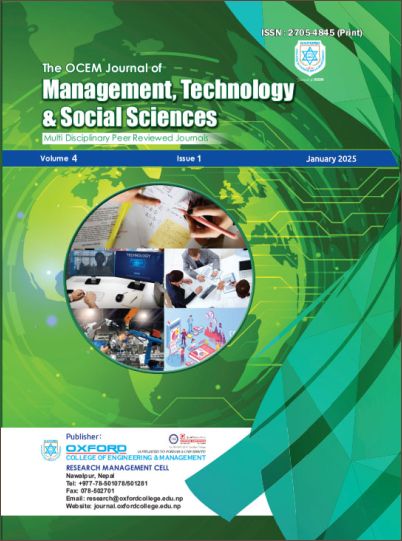Assess the Adoption of Improved Maize Production Technologies in Gulmi, Nepal
DOI:
https://doi.org/10.3126/ocemjmtss.v4i1.74760Keywords:
Adoption, agriculture, improved technologies, maize, yieldAbstract
This study investigated the adoption of improved maize production technologies in Gulmi District, Nepal. Ninety-six maize-growing farmers supported by the Prime Minister Agriculture Modernization Project, Maize Zone, Gulmi were randomly selected and interviewed using a pre-tested semi-structured questionnaire. Data collected from the Household Survey were coded, tabulated, and analyzed using SPSS 16.0 and Microsoft Excel 2012. In the study area, most of the respondents were male and most of them belonged to middle age (37-60 years) group. Brahmin was the dominant ethnic group an average family size of 6.35. Lesser contact with agriculture service centers and poor mechanization were the major constraints of adopting new technologies. The findings revealed that improved maize varieties were the most preferred seed source, with 76.00% of respondents selecting them; among these Manakamana 3 was the most widely adopted variety. However, only a few proportion of respondents (16.70%) practiced improved cultivation techniques, such as soil testing, agricultural lime application, soil treatment, farm mechanization, and chemical pest control. Most respondents (63.50%) were categorized as medium adopters of improved maize production technologies, with the selection of recommended varieties being the most favored practice. Statistical analysis indicated significant relationships between the level of adoption and factors such as age, ethnicity of respondents, access to mass communication, participation in extension programs, membership to farmers’ groups, visits to agricultural service centers, and subsidy receiving. Additionally, the fall armyworm was identified as a major pest, while black smut as a significant disease, primarily due to poor adoption of seed treatment practices.
Downloads
Downloads
Published
How to Cite
Issue
Section
License
Copyright (c) 2025 Authors and OCEM Journal of Management, Technology & Social Sciences

This work is licensed under a Creative Commons Attribution-NonCommercial 4.0 International License.
This license enables reusers to distribute, remix, adapt, and build upon the material in any medium or format for noncommercial purposes only, and only so long as attribution is given to the creator.




